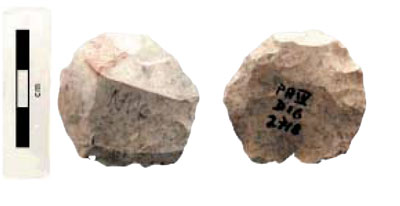
From about 250,000 to 35,000 years ago, during the Middle Paleolithic, or Mousterian, period, Neandertals lived in Western Europe. Although we occasionally find bits of their skeletal remains, our most common source of evidence is the stone tools they made. During the past 150 years of Paleolithic research, we have classified about 100 different types of tools, represented in different percentages at different sites. New archaeological finds indicate that other types of tools are waiting to be discovered.
This was the case at our site in southern France, Pech de l’Azé IV, where we recently identified an entirely new kind of Mousterian implement. One excavation level, dated to approximately 75,000 years ago, contained a large number of tiny Levallois cores. Levallois is the term for the technique of producing sharp bits of stone, called flakes, from a prepared lump of flint, called a core. Usually quite large, flakes were either used as they were or were subsequently modified into other kinds of tools, such as scrapers or points. By contrast, at Pech de l’Azé IV we have identified several such cores that are extremely small. The core shown here is only a little more than an inch across. The flake that came from it is much smaller.
What were the Neandertals doing with these small flakes? We have no evidence that they were made into other kinds of tools. In fact, there are very few tools in these layers. It seems likely that made the flakes small and thin to make them very sharp; if so, perhaps they were used for cutting meat. At the same time, the production of small flakes as tools represents an efficient use of raw materials, since more of them can be produced from a given volume of flint.
The presence of the flakes has also influenced how we excavate sites. If it had not been for the discovery of the small cores, which bear evidence of the purposeful manufacture of the flakes, we would not have seen them as consciously produced objects. Their small size would lead archaeologists to entirely overlook them as tools.
This kind of discovery shows just how little we understand Paleolithic stone tools in general, and Mousterian tools in particular. Archaeologists continue to argue about the possible uses of many of the stone artifacts we find at the sites, but it is surprising that we are only now recognizing an entirely new class of objects. What other discoveries of the past await us in the future?
Harold Dibble is professor of anthropology at the University of Pennsylvania and the Museum’s deputy director for curatorial affairs.
